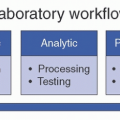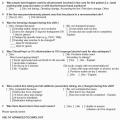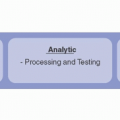Introduction
Candida are the leading cause of healthcare-associated fungal infections.
25 Although the
Candida genus of yeast includes hundreds of species, only some have been found to be pathogenic in humans. In the United States, sentinel surveillance for candidemia, four species (
C albicans [39%],
C glabrata [28%],
C parapsilosis [15%], and
C tropicalis [9%]) accounted for >90% of cases.
18 Other notable species associated with invasive candidiasis include
C krusei,
C lusitaniae,
C dubliniensis,
C guilliermondii, and
C auris (
Table 21-1).
C albicans is the most common pathogenic
Candida species, but non-
albicans species are on the rise and represent the majority of candidiasis in some institutions, changing the species epidemiology.
26,27 This is important because
C albicans is largely susceptible to antifungal drugs, but drug resistance is a concern for other species, like
C glabrata and
C auris.
C auris, though rare except in a few areas, is a species of great concern due to its high levels of drug resistance and ability to spread in healthcare facilities.
28,29
Candida cause a variety of different infections, and severity differs among body sites. Common noninvasive infections include oral thrush, vulvovaginal yeast infections, and diaper rash. Invasive candidiasis may involve the blood, eyes, brain, bones, heart, and other body sites and can lead to severe outcomes, like sepsis. Bloodstream infections (candidemia) are associated with high mortality rates (about 30%-60%) and have become one of the leading causes of healthcare-associated bloodstream infections in the United States.
2,27,30,31,32
Risk factors for candidemia and other invasive candidiasis include immunosuppression, recent surgery (especially gastrointestinal) or intensive care, antibacterial use, indwelling catheters and other medical devices, diabetes, intravenous drug use, and low birth weight.
18,32,33 Improved survival among cancer and transplant patients, along with newer immunosuppressive medications, has increased the population at risk for invasive candidiasis. Risk factors for
C auris infections have differed slightly from other
Candida species and have included mechanical ventilation, tracheostomy, broad-spectrum antibacterials, and care in a highacuity post-acute care facility.
This section focuses on the detection, transmission, and prevention of invasive candidiasis among in-patient populations.
Detection
Identification Because invasive candidiasis lacks pathognomonic symptoms, laboratory confirmation is required for detection and diagnosis. Often, the first sign that a patient may have candidiasis is nonresponse to antibacterial treatment. Rapid detection is important to avoid treatment delays as well as to expedite infection prevention measures when transmission is suspected or possible.
Candida can be detected though culture and cultureindependent methods. Commonly used culture-based methods for identifying
Candida include automated biochemical methods, matrix-assisted laser desorption ionization/time-of-flight (MALDI-TOF) mass spectrometry, germ tube test, and peptide nucleic acid fluorescence in situ hybridization (PNA-FISH). Unfortunately, the sensitivity of
Candida blood culture is low (˜50%).
35 Culture-independent diagnostics include polymerase chain reaction (PCR) and T2
Candida. MALDI-TOF and DNA sequencing are considered the most accurate methods but are not available in all laboratories. VITEK 2 is an automated biochemical method with high accuracy and a large species database and is commonly used. Conversely, germ tube tests and some other automatic biochemical methods are relatively common, but limit laboratories to identifying only the most common species.
36
The ability to identify the species of
Candida once it is detected is important because it can inform treatment and infection prevention decisions. Laboratories differ in their protocols for
Candida species identification. Some laboratories may only identify the species from sterile body sites because
Candida from noninvasive sites are often considered colonization rather than infection and are typically not clinically relevant. Therefore, identification of
Candida in certain body sites does not necessarily mean treatment should be provided. For instance, in most circumstances,
Candida in the urine or lungs would not prompt treatment as these usually indicate colonization.
24However, the recent advent of C auris has led to an increased appreciation of Candida species identification in body sites not necessarily reflective of infection. While person-to-person transmission is not a major concern for most Candida, C auris spreads rapidly in healthcare settings and therefore identifying C auris from any body site should prompt Transmission-based Precautions and infection prevention measures. Improved accessibility of accurate species identification from multiple body sites could help identify emerging species of concern and ensure appropriate infection prevention measures are implemented and effective treatment provided.
Drug Resistance The U.S. Centers for Disease Control and Prevention’s (CDC’s) 2019 Antibiotic Resistant Threat Report listed drug-resistant
Candida as a serious threat and
C auris as an urgent threat.
30 Drug resistance is concerning for multiple
Candida species, though resistance levels vary within and among species.
C albicans is rarely drug-resistant. In contrast, about 8% of
C glabrata isolates are resistant to azoles and about 3% are resistant to echinocandins in the United States.
18 C auris is highly drug-resistant. About 90% of
C auris isolates are resistant to azoles, about 35% are resistant to amphotericin B, and about 5% are resistant to echinocandins.
37 Some
C auris isolates have been resistant to all three major antifungal drug classes.
37
Because of this resistance, antifungal susceptibility testing may be important for treatment decisions, especially for patients with invasive disease, as well as for epidemiologic tracking. The Infectious Diseases Society of America (IDSA) recommends azole susceptibility testing for all invasive candidiasis and echinocandin susceptibility testing if the patient received echinocandin treatment or if the infection was with
C glabrata or
C parapsilsosis.
24 Antifungal susceptibility testing is commonly conducted by broth microdilution, gradient strips, disk diffusion, and automated methods. Broth microdilution is considered the gold standard by the Clinical and Laboratory Standards Institute (CLSI).
26 Unfortunately, antifungal susceptibility testing is often even less accessible for facilities than species identification. Susceptibility testing is additionally limited in that standardized interpretative breakpoints are only available for the six most common species and for the azole and echinocandin drug classes (
Table 21-1). Public health departments are increasingly capable of assisting with or providing guidance on
Candida species identification and susceptibility testing (eg, through the Antibiotic Resistance Laboratory Network, www.cdc.gov/drugresistance/laboratories.html).
Acquisition and Transmission
Many pathogenic Candida species are commensal organisms, colonizing the body, especially in the gastrointestinal, respiratory, and urinary tracts; vagina; and skin. Most Candida infections are caused by the patient’s normal fungal flora. Barriers, like the skin and gastrointestinal mucosa, protect against invasive infections. Infections may occur through autoinoculation due to disruption of such barriers (eg, wounds, placement or management of indwelling devices, or surgery). For example, abdominal surgery may trigger candidemia by enabling normal gut microbiota to translocate to the bloodstream. Candidiasis may also result from dysbiosis, or a disruption of a person’s normal microbial community, causing overgrowth of Candida (as seen with vulvovaginal candidiasis). Such overgrowth may put patients at higher risk of invasive infection, especially in the gastrointestinal tract.
Because
Candida infections are typically caused by normal flora, person-to-person transmission is often not considered a concern for
Candida. However, transmission, and even outbreaks, has been documented.
C auris has led to a change in the paradigm and is highly transmissible in healthcare settings and has caused outbreaks across the world.
29,38 C parapsilosis has caused outbreaks, often in neonatal intensive care units.
6,8 Outbreaks of other species are rare. Molecular typing has increasingly been used to confirm transmission.
39,40 For instance, whole-genome sequencing has aided epidemiologic investigations of
C auris outbreaks, by linking acquisition to the receipt of healthcare abroad and identifying local spread.
4Transmission of some
Candida species may occur through person-to-person contact (eg, hand hygiene breaches), contaminated shared medical equipment, or general environmental contamination.
40,41,42,43 Historically, environmental surfaces and fomites were not generally considered a source for
Candida infection. This thinking has changed with the emergence of
C auris, which has been shown to contaminate the environment when a patient with
C auris is present.
C auris has been isolated from many healthcare surfaces including bedrails, windowsills, and blood pressure monitoring cuffs and can persist on surfaces for weeks.
44,45,46,47,48 In the United Kingdom, one
C auris outbreak was linked to reusable temperature probes.
7







